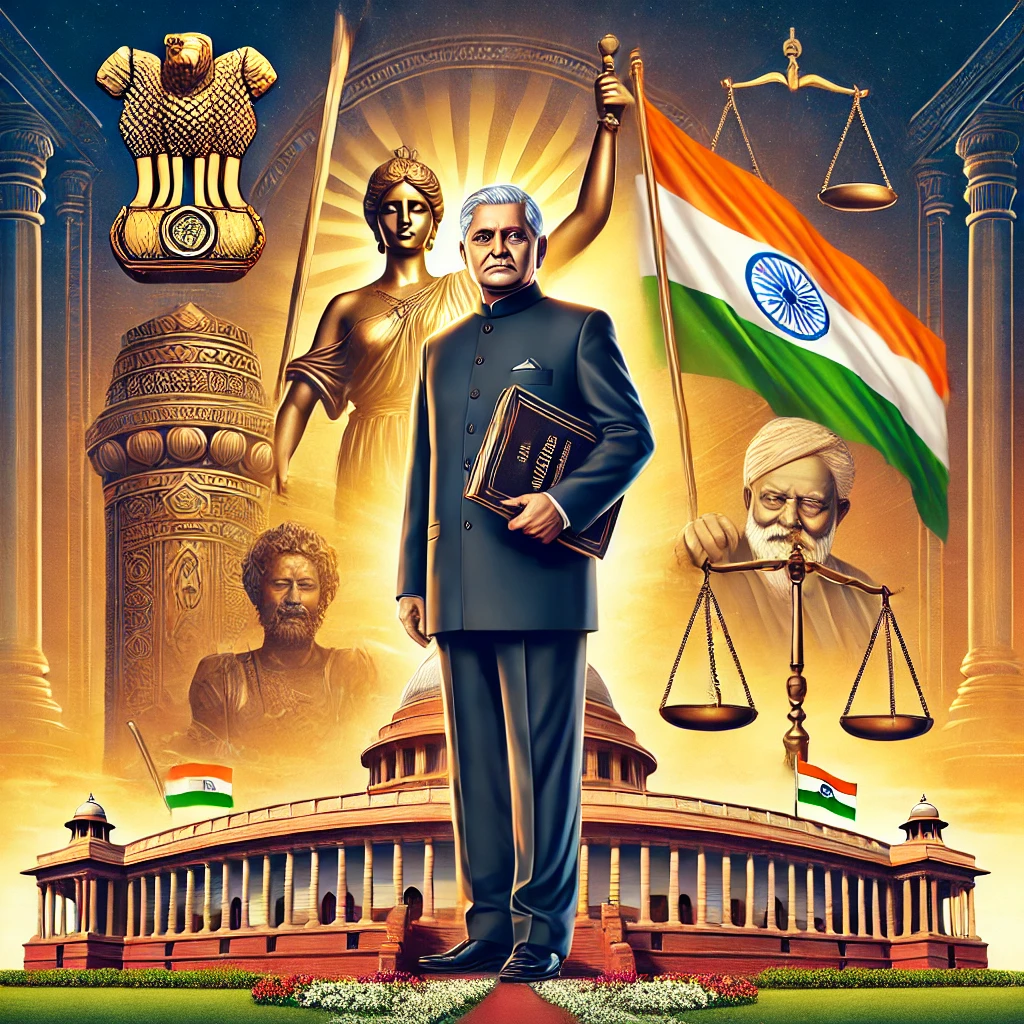
This article has been written by Parinitha, a 5th year BCOM LLB Student from St Joseph’s College of Law, Bengaluru.
Abstract
The President of India is a constitutional position that consists of one person the head of state and an executive authority. Though the majority of the functions of the President are exercised on the advice of the Council of Ministers, the Constitution has endowed the President with important functions in the fields of legislation, executive action, diplomacy, and the administration of justice. Though largely nominal, this power still plays a crucial role in maintaining the balance of power within the Indian political system. This article attempts to explore the constitutional powers and duties of the President of India- detailed analyses of how such powers interact with other parts of government as well as being constrained within the framework of parliamentary democracy.
KEYWORDS: Constitution of India, President, Powers of President, Parliament
Introduction
The office of the President of India assumes a very vital space in the constitutional framework of the country. He is often even considered a “nominal executive” with most of the real power lying in the hands of the Prime Minister and the Council of Ministers. Despite that, the Constitution grants to the President almost every responsibility and power available in the Constitution and often entrusts him with various other important functions without mentioning them specifically in the instrument itself. Most of these powers are exercised on the advice of the executive, but in all the above, it is the President who acts as a cornerstone in upholding the Constitution, ensuring there is continuity in administration, and taking control in cases of emergencies.
The role of the President, as perceived by the framers of the Constitution is being the watchdog of the Constitution and the political system. This essay attempts to offer an apology for doing just that: a contextual understanding of the same powers granted to the President under the Constitution of India: application and limitations, as well as its relevance in contemporary times.
Constitutional Provisions Governing the Role of the President
The Constitution of India has elaborately depicted the powers and duties of the President. Articles from Article 52 to Article 78 provide the legal framework for all functions and responsibilities of the President.
- Election of the President (Article 54)[1]
Indirect election of the president: The process is through an electoral college constituted by both Houses of Parliament and the elected members of the Legislative Assemblies of States. This process provides for the fact that the President is an embodiment of the will of the nation rather than the simplistic representative of the will of the center. The very process of election itself is framed such that it takes into account the interest of both the Union and the States, and it reflects the federal nature of the Indian Constitution.
- Oath of Office (Article 60)[2]
On assumption of office, the President takes an oath to preserve, protect, and defend the Constitution and the law. The oath therefore captures the very essence of the position as an impartial custodian of the Constitution, above party politics.
Article II, section 1 of the Constitution[3] vests all executive powers of the Union with the President. The powers entrusted can be exercised either directly by the President or through officers subordinate to them. Practically, the actual executive authority rests with the Prime Minister and the Union Council of Ministers.
This is a parliamentary model of democracy as borrowed from the British system, whereby the titular head is the monarch but the real power is exercised by the elected government. In the same fashion, the President of India is the nominal head of state, and in his or her name, the government functioned.
- Pleasure Doctrine (Article 311)[4]
The Doctrine of Pleasure, an ancient British legal doctrine, forms the foundation of Article 311 of the Constitution. According to this theory, the President has the power to determine who qualifies retained in their current position. Nonetheless, limitations limit how the theory is applied in India. Civil servants are protected under Article 311, which prohibits their being fired, demoted, or demoted in rank without due process and an opportunity to present their case. This guarantees job stability and acts as a check on arbitrary termination, both of which are essential for preserving an effective civil service.
The President is nominally in charge of the public services under the Doctrine of Pleasure, but in reality, this authority is limited by constitutional rights to appeal unjust decisions and protections for civil officials. These checks serve as a reminder of the difficult balance the Constitution strikes between individual rights and executive authority.
- Appointments[5]
One of the most significant constitutional powers of the executive is vested in the Presidency for the appointment of key officers. These include:
– The Prime Minister: The choice of a prime minister by the President, even as the choice may appear overt and obvious in a context of majority to one party in Lok Sabha, the institution of coalition governments and hung parliaments provides discretion for the President to choose a leader.
– Council of Ministers: On the advice of the prime minister, other ministers are appointed by the President to constitute the executive.
– Judicature: The President appoints judges of the Supreme Court and High Courts which goes a long way in determining the judiciary. This though is exercised based on the recommendations of judicial collegiums but still epitomizes the role that the President plays as an appointing authority on crucial matters pertaining to governance.
– Other Appointments: The President also appoints Governors, the Comptroller and Auditor General, Election Commissioners, and other high officials, who play a crucial role in maintaining checks and balances within the system.
The President’s Limited Discretion in Appointments
In spite of the vast seeming discretionary powers of the President in appointing officials, constitutional conventions have severely circumscribed them. The advice by the Prime Minister and the Council of Ministers is binding to the President; hence the exercise is largely ceremonial in most cases. Political instability situations like that of coalitions or being hung in Parliament raise the importance of discretion in the part of the President. This was most evident in the appointment of Prime Ministers in a coalition politics period in India, prominently during 1996 when no party enjoyed an absolute majority.
Supreme Commander of the Armed Forces
He is endowed with the official dignity of being the Supreme Commander of the Armed Forces. The power of declaring war and granting peace is retained by the President but on the advice of the Prime Minister and the Cabinet, which naturally circumscribes his constitutional independence in military matters also.
Government Contracts[6]
According to Article 299, all agreements entered into while a state or the Union exercises its executive authority must be signed in the name of the governor (for state agreements) or the president (for union agreements). This guarantees that the President has legal accountability for whatever contracts the government enters into, as the official leader of the executive branch.
The clause ensures that any contract made by the Union government is only legally enforceable if it is signed in the President’s name. It does this by protecting government personnel from individual accountability in commercial matters. The President’s legal responsibility to guarantee appropriate government behavior in business dealings is reaffirmed in this text.
Parliamentary Powers of the President
Participation in Proceedings of Parliament
The Indian Parliament consists of the President and the two Houses Lok Sabha and the Rajya Sabha. The President has multifaceted involvement in legislative affairs.
- Summoning, Proroguing, and Dissolving Parliament
The President can summon and prorogue sessions of Parliament. He can also dissolve the Lok Sabha, normally on the advice of the Prime Minister. This power came into use, for example, when, in 1999, President K.R. Narayanan dissolved the 12th Lok Sabha after the Vajpayee government lost a vote of confidence.[7]
- Assent to Bills (Article 111)[8]
One of the important legislative powers of the President is his right to give or withhold assent on bills passed by Parliament. The President may:
- Give Assent: The act of which converts a bill into law.
- Withholds Assent: If the President does not give assent, it does not become law.
- Veto the Bill for Reconsideration: Except on money bills, the President can veto a bill to Parliament for reconsideration. But if parliament passes the same bill again, the President is obliged to give assent.
- This provision allows the President a hold or capability to withhold legislation, though this check on legislative power is limited since the President cannot veto a bill that is passed again by parliament.
- Ordinance Making Power (Article 123)[9]
The President can, in his discretion, promulgate ordinances when the Parliament is not in session, and such ordinances have the force of law unless and until they are repealed or approved by the Parliament. However, such ordinances should be approved by the Parliament within six weeks of the next session of the Parliament. The ordinance-making power is significant since it enables the executive to tackle pressing matters when the legislative body is not sitting.
- President’s Veto Powers
Significant veto authority is vested in the President of India. These veto powers are divided into three categories: pocket, suspensive, and absolute.
Absolute Veto: This authority allows the president to refuse to sign a law. A bill that is subject to an absolute veto cannot get into law. Typically, this is only used for bills introduced by private members or if a government loses its majority before the bill is sent for ratification.
Suspensive Veto: The President may send a law back to the Parliament for further review, excluding money bills. The President must ratify the measure if it is approved by the Parliament once more, amended or not.
Pocket Veto: The President can essentially put a law in limbo by using his pocket veto power, which is to neither ratify nor reject it. President Zail Singh famously used this veto to postpone the signing of the Indian Post Office (Amendment) Bill in 1986. In contrast to other veto mechanisms, the President is not required by the Constitution to take action within a specific time range.
The President has some independence and discretion thanks to the veto power, particularly when it comes to dubious or contentious government initiatives.
Scope and Limits of Ordinance Making Power
Another area of much controversy has been the holding of an ordinance-making power since this gives the executive a temporary bypass of the legislative process. Critics argue that this power has sometimes been misused as a means of ramming through contentious laws that would not otherwise gain parliamentary scrutiny. However, subsequent approval by Parliament ensures that ordinances cannot be a permanent substitute for legislation. The President’s role in issuing ordinances further illustrates how the office depends on the advice of the Cabinet.
Presidential Financial Powers
Annual Financial Statement
An annual financial statement is presented as the Union Budget, which is presented before Parliament based on the recommendations of the President. Approving money bills, that are about the tax and expenditure-related sphere, is the President’s responsibility. This generates not withholding power of the government from taxing or spending without prior approval from the President[10].
Control over Financial Legislation
No expenditure bill from the Consolidated Fund of India can be enacted without the recommendation of the President[11]. This is a very important power, though its practical effectiveness is diluted by the advisory role of the Council of Ministers.
Judicial Powers of the President
Power to Grant Pardons (Article 72)[12]
- Also, the President has the right to pardon reprieves respites, or remission of punishments in certain matters. This involves a right to,
- Grant pardon to a convict who is awaiting the death penalty.
- Grant clemency in offenses against the laws of the Union.
- Grant reprieve to the decisions made by the military courts.
- Pardon or Commutation of Sentences is one of the absolute constitutional safeguards that give the right of the President to intervene in a matter where the judicial decision can demand humanitarian review.
- The Pardon Power in Practice
The pardon power has sometimes been at the epicenter of controversy, especially when big-name cases come to the fore. Although technically a power of the President, the latter will often act according to the advice of the Cabinet. Sometimes, politics can also edge into the exercise of this power. That bears out debates over just how independent and fair its process is. As always, the judicial review of the President’s pardon power is limited, which accounts for the finality of the power.
Emergency Powers of the President
Emergency powers of the President are perhaps the most important and far-reaching powers that have accrued to the office. The Constitution envisages three kinds of emergencies, which confer special powers to the President in connection with particular crises.
National Emergency (Article 352)[13]
A National Emergency can be declared when the security of India or any part of its territory is threatened by war, external aggression, or armed rebellion. During a National Emergency,
- The President has more control over state governments
- All or any constituent Article 19 can be suspended
- Parliament is vested with the authority to make laws for the subject, which are on the list of the State
President’s Rule (Article 356)[14]
A situation can be declared when a state government fails to act by the constitutional provisions also known as a State Emergency. Under President’s Rule: The executive functions of the state are directly undertaken by the President. The legislative powers of the state assembly are taken over by the Parliament.
A Financial Emergency can be declared if the financial stability of India is threatened. This type of emergency allows the president to guide the states on matters pertaining to finances and allows money bills passed by state legislatures to be approved as well.
The Use and Misuse of Emergency Powers
The most criticized use of emergency powers, particularly the President’s Rule, has been the dismissal of state governments for political reasons. The worst-ever violation of democratic norms was at the hands of the 1975-77 National Emergency, declared by Prime Minister Indira Gandhi[15]; civil liberties have been curbed and democratic institutions mauled. To check these powers, the 44th Constitutional Amendment Act insisted that greater parliamentary approval was required before emergency declarations could be made.
President’s Diplomatic Powers
India is represented in foreign affairs by the President, although their function is primarily symbolic. In the name of the President, treaties and agreements with other nations are negotiated and signed; nevertheless, Parliament must ratify them. In actuality, the negotiation of these accords is greatly aided by the Prime Minister and the Minister of External Affairs.
In addition, the President welcomes foreign diplomats to India and names high commissioners and ambassadors to other nations. The President of India holds significant implication in promoting international relations, signifying the country’s sovereignty and its place in the world economy.
Analysis: The President as a Diplomatic Icon
Even though the President’s diplomatic authority is primarily ceremonial, the office gives India’s international relations a sense of dignity and continuity. While the actual decision-making happens inside the Cabinet, the President’s involvement lends formality and weight to India’s stance during international diplomatic crises.
Conclusion: Analysis of Power Balance
Though highly ceremonial, the post of President of India is indeed profoundly saturated with constitutional powers. The office acts as a check to balance out the powers of each branch of the Indian political system and serves to bar one branch from exercising powers beyond its jurisdiction. Though the actions of the President are controlled by the advice of the Prime Minister and the Council of Ministers, at certain times, especially when such crisis or instability characterizes the political scene or national issues, the powers of discretion vested in the hands of the President become decisive.
However, the President’s powers are reframed within constitutional limits, which shows how Indians are committed to parliamentary democracy. The founders of the Constitution were cautious enough to design an office that, although dignified and powerful enough, would not cast an overshadowing shadow on the elected representatives of the people. In that way, the President is a guardian of the Constitution—a figure of unity and continuity in the unfolding democratic landscape of India.
[1] India Const. art. 54.
[2] India Const. art. 60.
[3] India Const. art. 2.
[4] India Const. art. 311.
[5] India Const. art. 74-78, cl. 1(a).
[6] India Const. art. 299.
[7] Shyamlal Yadav, How Vajpayee lost a no-confidence motion by one vote in the 1998 elections, Indian Express (May 28, 2024 22:26 IST), https://indianexpress.com/article/explained/explained-history/india-under-vajpayee-9351988/
[8] India Const. art. 111.
[9] India Const. art. 123.
[10] India Const. art. 112.
[11] India Const. art. 117.
[12] India Const. art. 72.
[13] India Const. art. 352.
[14] India Const. art. 356.
[15] 1975 Emergency explained: A look back at India’s ‘dark days of democracy’; Govt designates day as ‘Samvidhaan Hatya Diwas’, Economic India Times (Jul 12, 2024, 07:19:00 PM IST), https://economictimes.indiatimes.com/news/how-to/1975-emergency-explained-a-look-back-at-indias-dark-days-of-democracy/articleshow/111248087.cms?from=mdr







